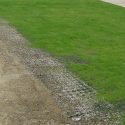In September 2015, the governments of 193 UN member countries signed an action programme for people, planet and prosperity. 2030 Agenda, with its 17 Sustainable Development Goals (SDGs), makes a clear assessment of the serious impact that the current development model has, not only on the environment, but also on the economy and society. Starting from the environmental and territorial level, the achievement of the objectives of 2030 Agenda can also be reached through sustainable choices and behaviour, both individual and non-individual, in every field of production and consumption, from agriculture to construction, from infrastructure to waste management. Soil consumption is one of the causes of floods and water scarcity; it intervenes in global warming, threatens biodiversity, reduces arable areas and accelerates desertification processes.
Materials for smart construction
Construction produces millions of tonnes of construction and demolition waste each year, which are often difficult to dispose of or recycle because of the variety of substances used. This entails the need to set up ad hoc landfills with the consequent destruction of soil.

When building or renovating, it is necessary to avoid as much as possible the use of materials from the petrochemical industry and always choose environmentally friendly, reusable and recyclable materials such as stone, iron and wood. Using wood in construction does not contribute to deforestation, if it is ensured that wood for construction purposes comes only from controlled felling forests, where the
felled trees must be replanted. These woods guarantee the improvement of the air, the lowering of the temperatures, the repopulation of the wild fauna and flora; they guarantee richness.
Flooring that does not consume the soil
The plant component and the bare ground absorb less heat than the materials normally used for external pavements (e.g. asphalt), thus helping to lower the temperature of the surrounding air.
For example: natural dry laid stones and wrought tuff or lapillus (a technique that consists inmixing the natural material – tuff or lapillus – with hydraulic binders).
Dry laid stone blocks

Wrought tuff - Reinforced grass carpet
Grass carpets, reinforced with gratings, can be ideal for small and large areas with reduced traffic.
Stabilised soil is a technique that improves the quality and mechanics of the soil on site, thanks to the use of a bio-catalyst based on complex inorganic salts, which increases its compactness and mechanical resistance, and is 100% recyclable.
Organic farming
This production method covers both crops and breeding and allows only the use of natural substances, excluding genetically modified organisms (GMOs), chemical fertilizers, herbicides, insecticides, etc., using species resistant to disease and appropriate cultivation techniques. This reduces the negative impacts of agricultural activities on air, soil and biodiversity.

Reuse
Re-use already waterproofed areas and abandoned buildings, reduces the consumption of green areas and the consequent further waterproofing of soils. Compensation and de-waterproofing projects
Projects should include activities that limit waterproofing as much as possible and mitigate its consequences using ‘compensatory measures’, which reduce the impact by recovering soil. It can also be envisaged to de-waterproof an area as an improvement.
Sustainable waste management and packaging reduction
The remediation of contaminated sites, the reduction of the landfill site size through the correct recovery of sorted waste and the reduction of the number and quality of packaging contribute to the protection of the soil and the environment.





